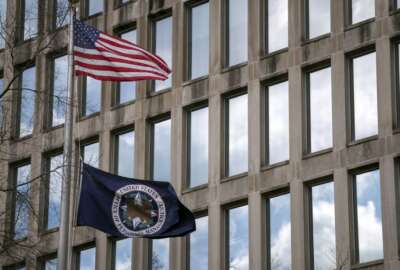Hubbard Radio Washington DC, LLC. All rights reserved. This website is not intended for users located within the European Economic Area.
On Air: Federal News Network
Trending:
Feds choose to stay longer, creating new retirement bubble
The retirement tsunami has long been the \"boogeyman\" of federal HR managers -- that baby boomers would be leaving the civil service in droves as they became e...
Each day, more and more members of the baby boomer generation are reaching retirement age, which many have long believed would trigger the federal retirement tsunami.
But what if another scenario were actually taking place, in which large numbers of older feds seem to put off retirement and continue to work instead?
That seems to be what’s happening according to the results of a new exclusive online survey Federal News Radio conducted as part of our special report, The Reverse Retirement Wave.
Throughout the three-day special report we’ll examine what factors impact employees’ decisions to leave or stay in government; how agencies are preparing to transfer knowledge from today’s leaders to those of tomorrow; and, how today’s federal HR leaders are collaborating with their colleagues in the upper levels of agencies, and coordinating with the Office of Personnel Management and the Office of Management and Budget, to build a framework for the workforce in 2025.
View the results of the survey based on respondents who answered they are retired from federal government or those who are still working. Due to the logic of the survey, not every respondent answered every question.
Of the 1,472 people who took the survey, 280 said they had already retired, but the vast majority — 1,192 — still are working for the federal government.
About 70 percent (722) of the working respondents have been civil servants for 20 or more years, and the majority of them are GS-11 and above. Most of them said they are 51 to 65- years-old (718), so they are either at or approaching retirement age.

It’s in the results of the survey of who is eligible to retire and when they plan to retire that the troubling data is revealed.
Of the working respondents, 45.6 percent (466) are eligible to retire and most of those employees have been eligible to retire for more than a year.

When asked when they planned to retire, most of the retirement-eligible feds (44.79 percent) said they would be leaving the government in 1-3 years. But significant numbers said they planned to leave in four-to-six years (21.73 percent).

Ron Sanders, vice president of Booz Allen Hamilton and a former chief human capital officer for the Office of the Director for National Intelligence, said he sees the responses to the survey as representative of the current make-up of the federal workforce, a generally senior, older, higher pay-grade populace. He added that he was also “alarmed” by some of the information it presented.
“What I worry about is what that demographic is going to look like in three to five years, because I do think there is a retirement bubble,” Sanders said. “I think the numbers bear that out. You have a fairly substantial number of folks who are postponing retirement, and I think that can only last so long. I worry about the trough that’s behind them, because we have now been managing the federal government’s workforce largely through hiring freezes and attrition through the better part of half a decade. … We’ve been through that before and we know the negative consequences of that.”
Reverse Retirement Wave Panel: Ron Sanders, Jeff Neal and John Salamone
Sanders spoke during a panel discussion on In Depth with Francis Rose, along with John Salamone, vice president of FMP Consulting, and Jeff Neal, senior vice president of ICF International, a NAPA fellow and former chief human capital officer of the Homeland Security Department.
Comparing the working feds to the retirees who responded to the survey, the two groups have similar makeups. The majority of retirees are either 51 to 65-years-old (113) or over 65 (83). Nearly 95 percent of them spent 20 or more years working for the federal government, and the majority of them were a GS-11 or higher at the time of retirement.

Neal said he does not subscribe to the idea of an impending retirement tsunami about to crash into the government. The data doesn’t support it, he said. For one thing, the federal workforce is not a static thing. Its makeup always is changing. Retiring feds will be replaced by employees who are not eligible for retirement yet.
In addition, other factors weigh into the when-to-retire decision-making process.
“Although, at a micro level, one or two people at a time maybe decide to retire based on a horrible experience with a supervisor or they’ve been furloughed one time too many or had one pay freeze too many, for the most part, people make that decision — one of the biggest life-changes they make — to retire based on can they afford it and are they ready to retire,” Neal said, adding that the survey supported that point.
When the retirees ranked what factors had the biggest impact on their decision to retire, the top three answers were “I could afford to retire”, “I was ready to retire” and “Job satisfaction.”

When Sanders was the CHCO at IRS, one of the factors he looked at in assessing when people would retire is the “propensity to retire”, the number of years a person waits to leave once they become eligible to retire.
“One of the things we found, and these patterns persist almost without regard to the economy, especially at the more senior levels, is that it’s a function of occupation,” Sanders said. “As you would expect, for example, an IT person has a much higher propensity to retire post- eligibility than say an HR person or a budget person whose skills may not be as marketable. I’ve seen those patterns in domestication season in Defense and they do vary depending on the health of the external economy but not a lot.”
If CHCOs spent more time looking at that, Sanders said, they’d have a better idea about what the job pipeline would look like and they could better prepare for knowledge-loss coming from upcoming retirements.
One of the retirees who responded to the survey said that he was within nine months of maxing out his retirement at 41.8 years when he decided to leave.
“After 3 years of no salary increase at least retirement benefits have COLAs, I got 1/12th the COLA by retiring in November 2012,” he wrote. “I also had 17 days of lose or use and it would have taken until August to earn that back. So, I took retirement and cashed in the 17 days. I was designated an assistant U.S. attorney doing bankruptcy work which I enjoyed. With the agency’s financial cuts, so was my work as a SAUSA. Not that the job was all fun, but it was a significant cutback in what I enjoyed doing. It made my decision to leave easy.”
Other retirees expressed similar frustrations that contributed to their decisions to retire.
“Tired of re-inventing the wheel,” one wrote. “No leadership at agency. Morale low. As a supervisor, tired of babysitting employees.”
Another wrote: “A big factor not included in the list above was the attitude of Congress and the public regarding federal employees, our pay and benefits and the worth of what we accomplish. All the unfair criticism with few defenders made it harder and harder to feel I was doing work worth doing.”
Working feds responded nearly identically when asked what factors they would consider when deciding when they should retire, with “Health/family reasons” coming in a close fourth.

Working feds who are eligible to retire ranked the “Pay and benefits,” “Job satisfaction” and “Health/family reasons” as the top reasons they haven’t retired yet.

Salamone said he was not surprised to see so many people saying they were continuing to work beyond the point they were eligible to retire. What did surprise him, though, was how few said they participated in knowledge transfer to the rising rank of employees.
“There was no time given for the training,” one retiree wrote.
Others, however, did have opportunities to train their fellow employees before they left.
“During my one-year re-employment, I helped train several new hires, as well as the person who took my management position,” one wrote.
The phased retirement program was established as a way for retiring feds to pass on knowledge and experience to the next generation of managers. The majority of retirees who responded to the survey (62.37 percent), though, said they did not help train a new employee to replace them before they retired.
“It was interesting to see a slight shift in a more positive direction for those individuals that are reaching retirement eligibility,” Salamone said. “They seemed a little bit more in focus and positive in terms of the ability or at least the interest in training those that were in the pipeline behind them.”
Many agencies tend not to have a big pipeline of talent to draw upon.
“They worry about the one person who gets the job,” Neal said. “And if I’m retiring, most likely, I’m not going to have any overlap with the person who’s replacing me. So, I think the fact that we tend to treat these as sequential actions, where someone retires and then someone new comes in, we don’t give them the opportunity to have any overlap. Absent that overlap, the person who is leaving doesn’t have a chance to train the person who’s going to replace them or who’s going to fill their job.”
While an overwhelming number of those working feds who responded to the survey (92.67 percent) said they were aware of the phased retirement program, most said they didn’t plan on participating in it when they retired.

Many of the comments about phased retirement centered on agencies not offering or not having it in place yet.
“My agency, SSA, is not offering phased retirement or I might have taken advantage of it,” one retiring fed wrote. “My desire was to reduce my commuting time which would have been achieved by either reasonable telework or phased retirement. Lacking either option I’m retiring with 35 years, 10.5 months of service.”
“From what I have been told, phased retirement is at least one year away for my agency,” another respondent wrote. “I don’t know if I want to wait that long.”
Sanders said he was surprised to see the general lack of interest in the survey to phased retirement. Agencies should phase out an employee, he said, rather than have an abrupt departure occur, where there is little or no knowledge transfer.
“I thought the phased retirement approach, while I would quibble with some of the details and the regulations, I thought it was spot on,” he said. “I’m hugely disappointed that it really hasn’t caught on like I thought and hoped it would.”
MORE FROM THE SPECIAL REPORT, THE REVERSE RETIREMENT WAVE:
Part 2: Rehired annuitants help bridge agency skills gaps, but are they enough?
Part 3: Mentoring helps young feds answer the question, ‘What’s next?’
Part 4: Feds ride the money, benefits wave longer than expected
Part 5: Recruiting, retention key to bucking federal retirement trends
Part 6: Military-style personnel system could smooth path to next-generation workforce
Part 7: Six signs of hope for the federal workforce of the future
Commentary: Time to start planning new retirement reality
Copyright © 2024 Federal News Network. All rights reserved. This website is not intended for users located within the European Economic Area.
Michael O'Connell
Michael O’Connell is senior digital editor of Federal News Network optimizing content for the best user experience. Follow @moconnellWFED
Follow @moconnellWFED
Related Stories
Related Topics





